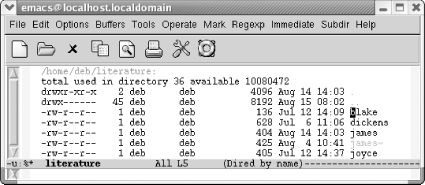Using Dired, the Directory Editor
Dired is one of the most interesting features of Emacs. With Dired, you can look at a listing of all the files in a directory, delete them, rename them, copy them, and perform almost all basic file operations. More important, Dired can make you more productive. For example, you can work with groups of files, deleting, moving, compressing, or even query-replacing strings in them.
There are several ways to start directory editing. If you're not in Emacs, invoke Emacs with a directory name as an argument, for example:
% emacs literatureEmacs starts up editing the directory literature: you'll see a single window that contains a listing of the literature directory. You can also start the directory editor by using C-x C-f (or any other command for visiting a file) and naming a directory, rather than a file. For example, typing C-x C-f literature gets you ready to edit the literature directory. Typing C-x d (for dired) or selecting the folder icon on the toolbar also starts Dired; you then specify a directory name. Finally, dragging a folder onto the Emacs window also starts Dired.[2]
No matter how you start the editor, the result is the same.
|
Type: C-x C-f literature Enter |
|

|
|
A basic directory editor display. |
As you can see, Dired's display is similar to what you see if you type ls -l at a Unix shell prompt. The permissions associated with the file, ...
Get Learning GNU Emacs, 3rd Edition now with the O’Reilly learning platform.
O’Reilly members experience books, live events, courses curated by job role, and more from O’Reilly and nearly 200 top publishers.

